Digital Content Strategy: Set Yourself up For Online Success
Why does Seth Godin, one of the world’s most renowned marketers consistently preach that the best form of marketing, is digital content strategy?
Because if you offer in-depth, high-quality content you can reach your audience without spending an astronomical amount of money.
If you specialize in paid advertising, you’ll know just how expensive that can be.
So, what’s the drawback then? Why isn’t everybody investing time in digital content marketing?
A good question. Honestly, there aren’t any drawbacks.
Yes, it takes a long time to build the foundations of a successful digital content strategy (it certainly doesn’t happen overnight) but once they’re set, you’ll certainly find it time well spent.
A common problem we’ve encountered with many of our students is that they kind of get all the above. They understand the importance of content.
However, with no direction, strategy, or common goals aimless production can be time-consuming and, well, aimless...
This is why I put this guide together.
It will teach you how to create a digital content strategy that sets the foundation for all your future content marketing efforts.
If that sounds good, read on!
What is Content Marketing?
Content marketing comes under the umbrella of inbound marketing and can be defined as:
“The production and distribution of high-quality content (videos, blogs, eBooks, etc,.) that while not explicitly promoting a brand, is intended to encourage leads to become paying customers.”
Content must be relevant, useful, and of practical use for the target audience.
Yes, the objective is still to capture leads, but in exchange for something valuable.
The aim is to have potential clients coming back to your brand (and even better, referring you) because they want to read, watch, and listen to what you have to say.
Successful content marketing strategies all focus on generosity.
Before talking about your product and beating customers over the head with it, you have to serve up free content that’s useful to them.
If you are a mobile CRM provider whose primary audience is sales directors, then you might think about creating an eBook on sales strategies.
While your product isn’t a consultative sales service, it’s still a valuable resource for your target audience.
Now you understand the basic principles of content marketing, let’s have a look at some of its advantages over other marketing methods.
Why Create a Digital Content Strategy?
The fact of the matter is, people, care a lot more about their problems than they do your product.
Sorry, it’s just the way it is…
So what you need to do is offer something useful. Grab their attention with content that offers solutions to these problems. Then (once you’ve got their attention) you can start to talk about your product.
Digital content also bolsters other areas of your marketing strategy:
Creates A Positive Impression With Your Audience
When you freely offer content that helps potential clients overcome a problem or learn about a specific topic, they are going to be grateful for your assistance and begin to trust your brand.
Imagine you sell online courses on how to manage social media channels. If you offer a content package that includes 3 templates:
An editorial calendar
A metrics report
An advertising budget
You’re providing resources that help your audience with their day-to-day work.
What you ask for in exchange is their contact information (full name, email address, telephone, role at the company, etc,.) which is something you can use in future marketing campaigns.
Increases Lead Conversion Rate
Capturing leads and building a rich database of potential clients is the primary goal of every online business, and content marketing is the best tactic to fill that database to the brim!
Going back to the previous example of online social media courses, the pack that included 3 templates is what’s known as a lead magnet.
If you’ve not come across the term before, a lead magnet is:
“High-value content (eBook, webinar, tutorial, podcast, infographic, etc,.) that’s offered to users freely in exchange for their contact details.”
Why do lead magnets boast such high conversion rates?
It’s simple. Imagine you are the business owner of a social media course company and start to receive a lot of traffic to your site.
You decide to redirect this traffic to a landing page where you only talk about the different courses you offer - which ones are best, which ones turn you into a leading community manager, etc,. With a pricing guide beneath each one and a payment link.
Now imagine a different approach.
This time you redirect traffic to a landing page where readers have the option to download their pack of 3 free templates?
You’d choose the templates every time, right?
Put yourself in a potential customer’s shoes. The internet is full of businesses like yours offering online social media courses.
If you want them to choose you, over a competitor, you have to first position yourself as an authority in the market.
You have to demonstrate you are experts in your field, and the best way to do that is by offering relevant, high-value content (in this case 3 social media templates).
If readers that land on your lead magnet page are also interested in enrolling in an online course, then you can be sure a high percentage will convert into customers. This is why high-quality content is great for improving CRO (conversation rate optimization).
Helps With Your SEO Strategy
Content marketing and SEO go hand-in-hand. Good keyword targeting helps you position towards the top of search engine results (Google, Bing, Yahoo, etc,.) and for video positioning on YouTube.
The higher up the results page you appear, the more traffic you are likely to see on your web page.
Again, going back to our social media courses example, if you research what terms people are Googling for regarding social media, you can create content focused on answering some of their queries.
Imagine there are a lot of searches for “how to create an editorial calendar for social media” in Google.
If you publish an article that answers this question in-depth and positions itself towards the top of the Google search rankings, the traffic received is going to be of extremely high quality.
If a reader is interested in learning how to create an editorial calendar and your post explains:
How to run a social media audit
How to identify which types of content to publish
When’s the best time to publish
How to define specific social media KPIs
It’s likely the user is impressed by the depth you’ve gone into, subscribes to your blog, and perhaps in the future purchases one of your online courses.
Remember, that organic traffic is typically of higher quality as readers arrive after searching for something specific related to what you offer.
Though don’t think SEO happens overnight.
It’s something that can take months of good quality content production before results are seen.
Getting your lead magnet to appear at the top of Google’s search results can take months of hard work.
How to Build A Digital Content Strategy
Now that you understand the why behind building a digital content strategy, we’re going to look at the how.
Think of this next section of the post as the digital content strategy best practice guide
Outline Your Goals
Producing high-quality, valuable content for your audience is an admirable endeavor.
However, by itself, it achieves little for the company except, perhaps, a nice pat on the back.
Ultimately, your content must eventually trigger your readers to do something. An action that helps the company achieve its business goals.
Therefore, the first step of any digital content strategy is to outline those goals.
Now, Jodi Harris over at the Content Marketing Institute suggests there are 3 business goals content can help you achieve.
Those are:
Sales - content aimed at supporting specific revenue-driving campaigns
Cost-efficiency - content that increases the ROI of marketing campaigns
Business growth - content that supports the release of new product lines, etc.
You need to decide which of those areas is your primary focus.
For example, if you decide to focus on Business Growth, then brand awareness would be an area of content you’d want to focus on.
Guest articles, podcasts, and branded “how-to” guides are great ways to help support this goal.
Conversely, you might want to focus on cost-efficiency. If that’s the case, then SEO and increasing organic traffic to your website would be your best bet.
Outline your goals, and then decide how (and which type of) content helps you best achieve them.
Identify Your Sweet Spot
Once your goals are defined, it’s time to uncover your “sweet spot” or niche.
A common mistake content marketers make is trying to appeal to everyone. Unfortunately, that very rarely works. There’s always someone better positioned to write about certain topics, than you.
So, what is a sweet spot?
“It is where your particular fields of knowledge and your skill sets intersect with a passion point — something you feel is of great value to you personally, or to society at large.”
To uncover it, try asking yourself some of the following questions:
Are there any particularly underserved subject areas within your industry you could talk about?
Is there a particular buyer persona you’re struggling to gain traction with? Could content help you with that group?
Is there a particular area of our industry you’re considered experts in? What’s the content landscape looking like for that particular niche?
Answering these questions will help you narrow down your ideal target audience.
Create Your Buyer Persona
Speaking of the ideal target audience, the next step in your digital content strategy is to identify and create your buyer persona(s).
Buyer personas are:
“A fictional representation of a typical target customer”
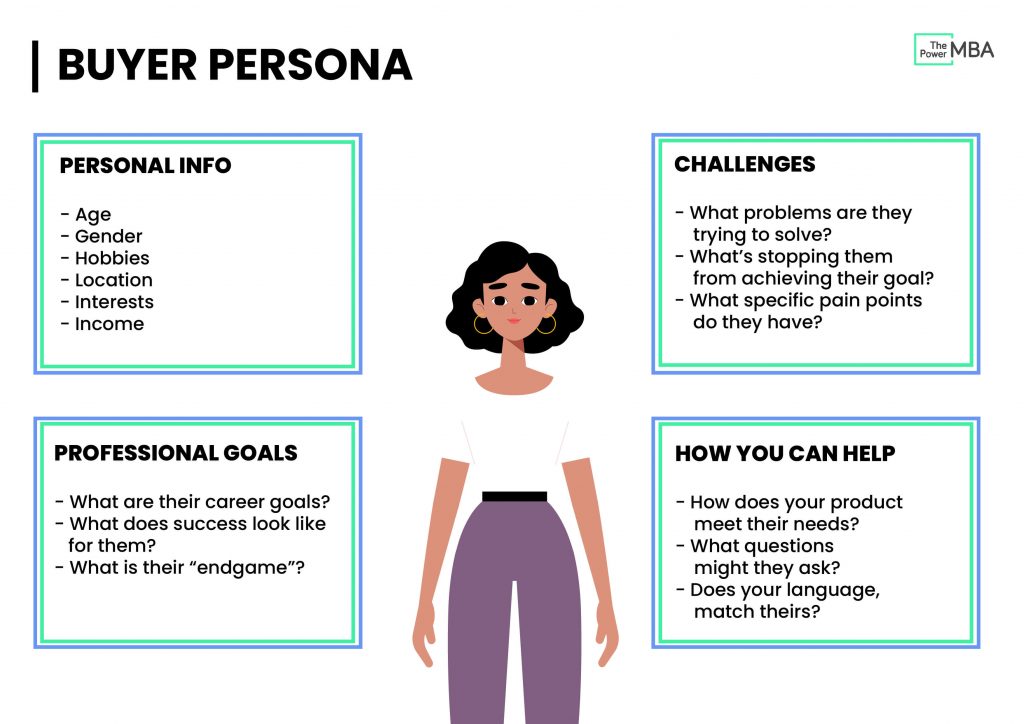
They help you (and most importantly, copywriters) to understand who exactly you’re writing to. By addressing a specific person your content will feel authentic - as if speaks directly to their needs.
So, how do you go about creating one?
By answering questions to four specific categories:
Personal Info
Challenges
Professional goals
How can you help?
This is always best done in conjunction with the sales team and customer service. They’re the ones interacting with your customers (and potential customers) daily, and from my experience, nobody has a greater understanding than they do.
So, when possible, get heads of marketing, sales, and customer service in a room together and fill in this grid.
It’s vital if you want your digital content strategy to be a long-term success.
Content Funnel
The next step is to build the overarching system your digital content strategy will stand upon.
The content funnel system is designed to guide as many readers (leads) through a layered flow, eventually converting them into paying customers.
The top of the funnel (TOF) is the widest section. This is where a large number of leads become aware of your brand, products, or the services you offer.
As they move through the middle of the funnel (MOF), many drop off as they realize the content doesn’t cater to their exact needs, or the product isn’t what they are looking for.
Finally, a very small number of leads pass to the very bottom of the funnel (BOF) with an extremely high chance of becoming paying customers.
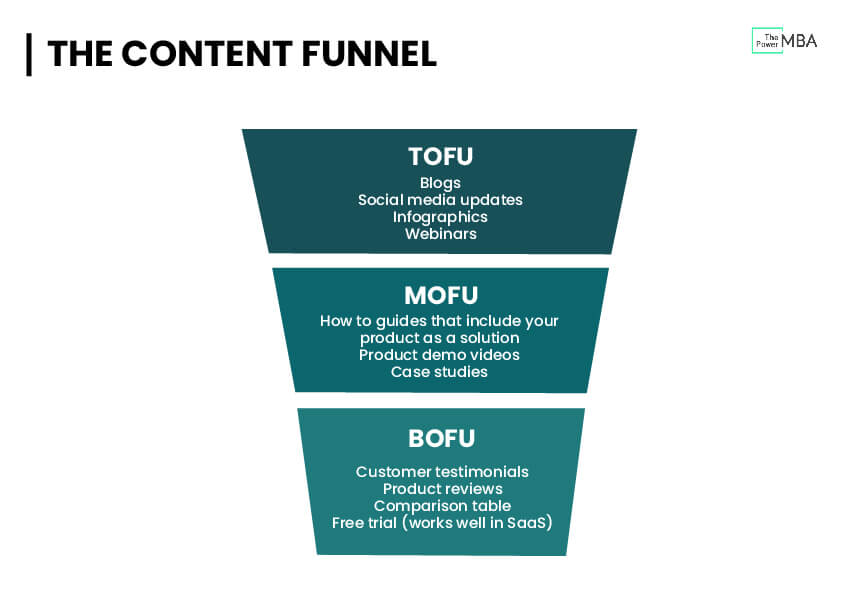
Top of the Funnel (TOF) - Discovery
During the discovery phase, your goal is to generate awareness of your brand among potential customers.
This is also where many brands get it wrong.
You see, this isn’t the time to be talking about yourself and how great your product is.
Instead, it’s about figuring out what your audience’s pain points are and delivering valuable content to help overcome them.
This generates trust in your brand (if the content is relevant and useful) leading them to begin associating your brand with a given topic. When done right, you should start to build a steady subscriber list and following on social media.
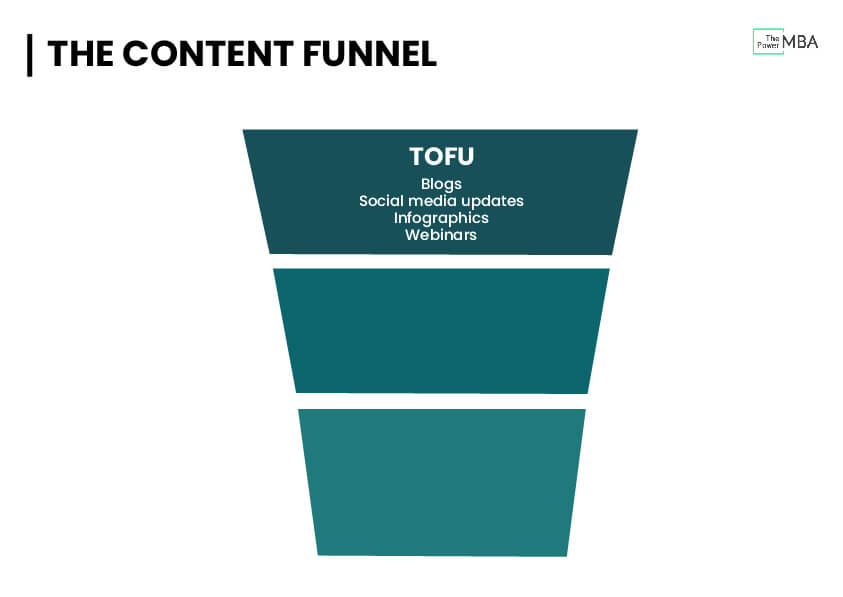
TOF stage content:
Blogs
Social media updates
Infographics
Webinars
Middle of The Funnel (MOF) - Consideration
During the consideration phase, consumers are starting to associate your product or service as a potential solution to their problems.
Now is the time you can open up about your different offerings.
But remember, you haven’t completely earned their trust yet, so don’t go beating them over the head with your product. Rather use this stage to guide them to information that helps them differentiate you from your competitors.
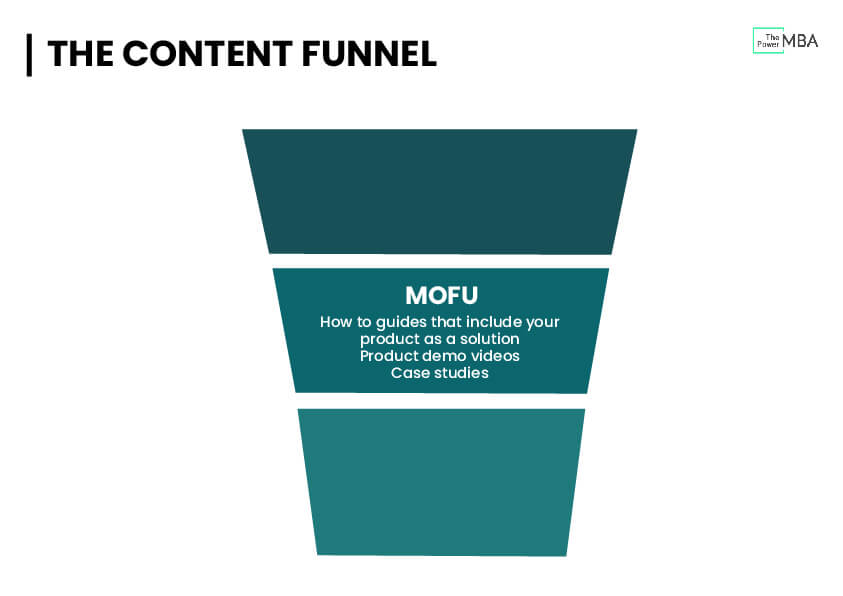
MOF stage content:
How to guides that include your product as a solution
Product demo videos
Case studies
Service overview sheets
Bottom of The Funnel (BOF) - Decision
All the hard work wining and dining you potential customers is finally over, now it’s time to convert those visitors and subscribers, into customers.
You can be a little more aggressive here, as it’s likely readers who remain engaged with your content at this stage are interested in your product.
It’s just about trying to nudge them over the line. Any final queries or doubts they have with your solution need to be answered.
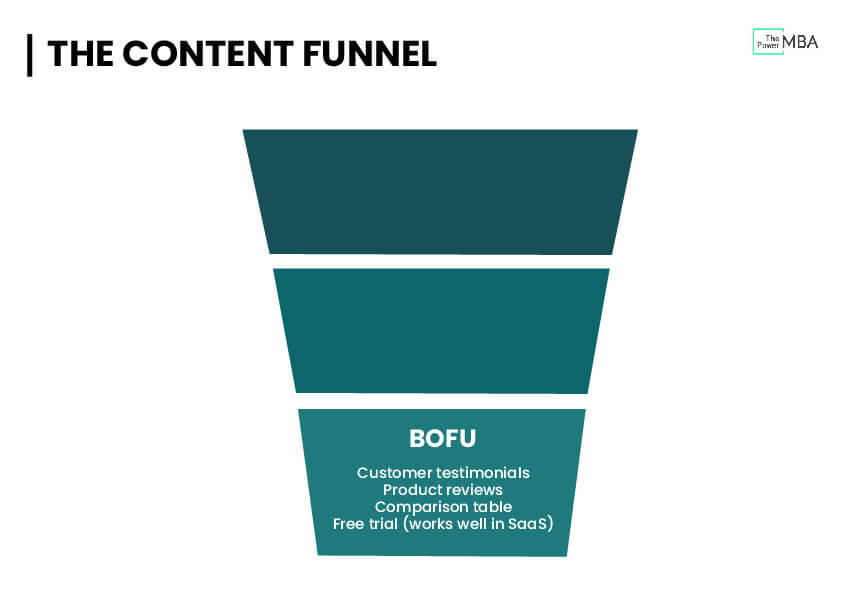
BOF stage content:
Customer testimonials
Product reviews
Comparison table
Free trial (works well in SaaS)
Digital Content Formats
Now that you’re familiar with some of the major advantages of content marketing, it’s time to look at some of the most widely used digital content strategies.
We are going to explain which are the most common formats and the best channels to distribute them.
So let's begin with the most popular, and easy-to-start of them all
Blogging
The bread and butter of all content marketing strategies, blogging is effective on just so many levels:
Search engines love new content, making live blogs a great SEO tool.
With accurate keyword targeting, they can bring a great deal of relevant, organic traffic to your website
If the content is compelling and offers value to your audience, you can build a trusted community through your blog.
Become a thought leader and reference for your industry.
Capture lead data through subscriptions.
What’s more, it’s incredibly easy to get started.
With the introduction of content management systems (CMS) such as WordPress, they are seamlessly integrated with the rest of your site, and with a bit of time and an internet connection can be started immediately.
However, that doesn’t mean to say that it’s easy to do it well.
For the content to be relevant and of value to your audience, it will typically have to be written in considerable depth.
This takes a lot of time and often a dedicated member of the marketing team to manage, write, and optimize the content.
Also, Google loves detailed content.
The more detailed it is, the more positive ranking signals it gives out and the better chance it has of appearing towards the top of Google’s search results.
You’re also going to have to be consistent.
To get users coming back to your blog you’ll need to publish weekly to keep the site looking fresh. Hubspot is a company that does this extremely well.
If you head over to their blog right now you’ll see that it’s split into several, clearly labeled sections to help guide the reader.
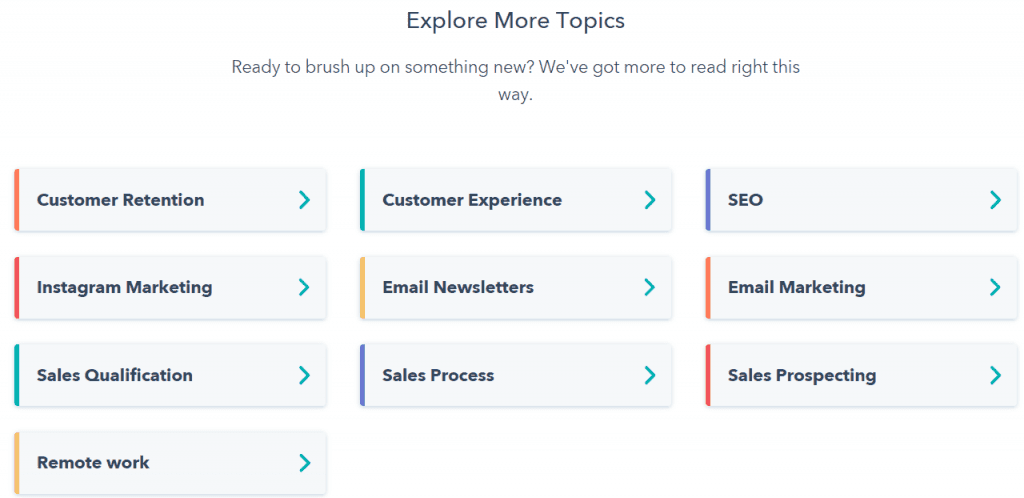
With a clear option to subscribe to their content (in exchange for your email, of course) if you found it useful.
With each post targeted at a specific keyword, covering the topic in detail.
*note the 7 min read notation above the title
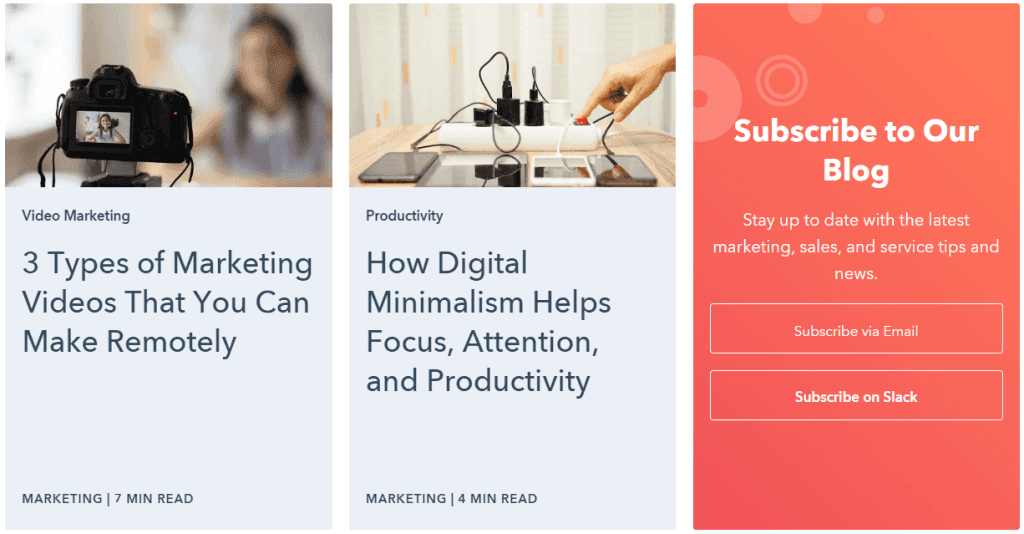
If you're looking to start a blog, check out our recently published blog post checklist guide. It's full of tips and ideas on how to increase organic traffic to your website.

eBooks and White Papers
Sometimes it's better to have a piece of content ranking well in Google, than sitting behind a subscription wall.
But often the opposite is true. This is where eBooks and white papers come in to play.
These long-form, in-depth content pieces cover a particular topic or industry in great detail, such as The State of Mining in Western Australia or The Definitive Guide to B2B Copywriting.
To match such a ‘grandeur’ title the content included needs to be equally rich in detail. This makes these content formats an effective, but time-consuming venture.
They are typically promoted alongside blog posts that cover related subjects. This way readers who land on a blog post about selling techniques may be given the option to download an eBook on sales strategies.
While reading a post on Local SEO Hubspot promote a related piece of gated content (an eBook in this case) in the bottom right-hand corner.
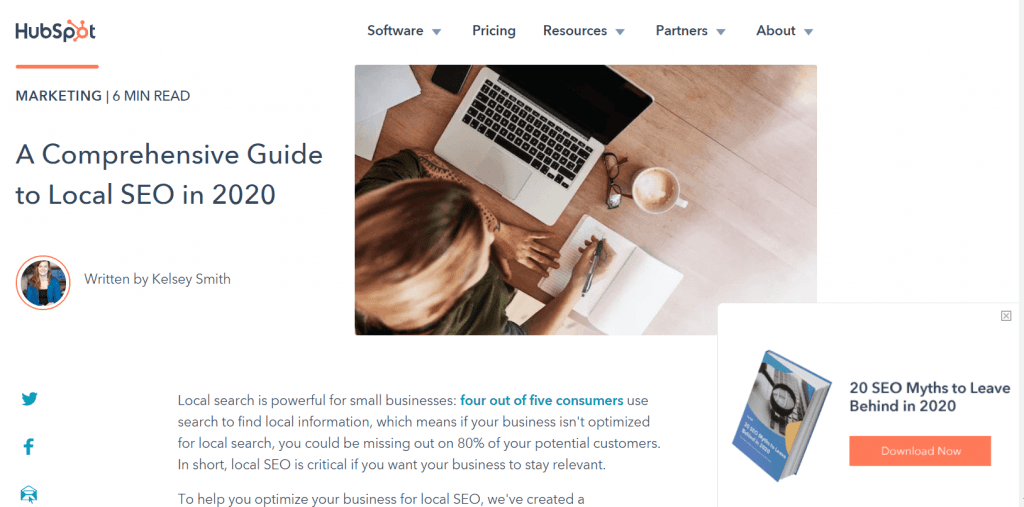
I’m able to access the guide in exchange for my First Name, Last Name, and Email, with an option to subscribe to their newsletter.
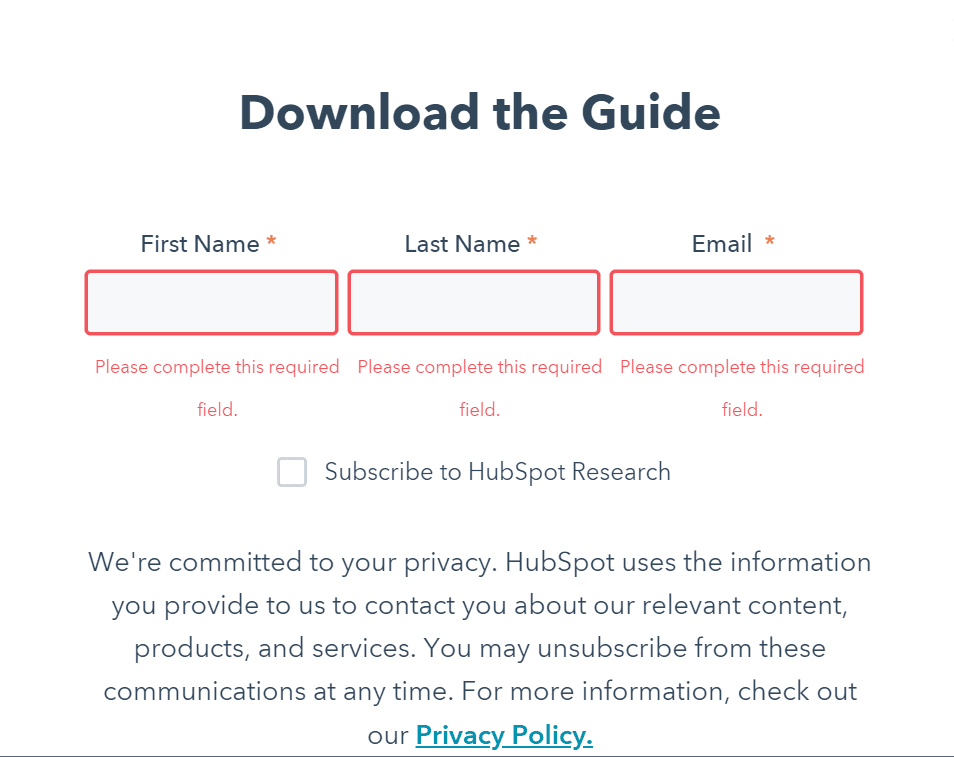
Infographics
An infographic is:
“A visual representation of a set of data, information, or concept.”
They are great for summarizing or giving an overview of a topic in an easily digested, visual format and are a welcome alternative to the monotony of a 3000-word blog post.
Good infographics use striking, engaging visuals to communicate information quickly and clearly without making the reader feel overwhelmed with data.
Typically they are introduced to support concepts in a blog post, eBook, white paper, or shared individually over social media.
We decided to break down some interesting data gathered about people’s online behavior in 60 seconds.
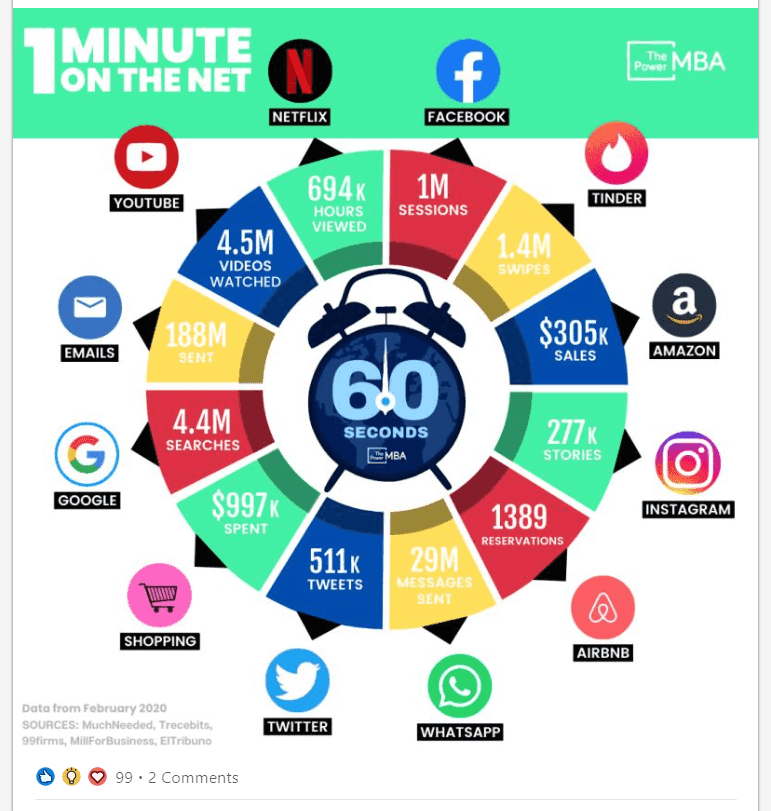
Webinar
A webinar or ‘online seminar’ is:
“A virtual meeting held between the host (business) and their audience.”
This can be on any topic your audiences’ interests intersect your topic of authority. So if you’re an SEO consultancy, a topic that bridges between audience interest and company authority could be nurturing customer experience from search, to purchase.
Some of the benefits of a webinar are:
Can be held live or recorded (live allows for a Q&A)
Unlimited audience size
Potential to gate webinars to build a subscriber list
Can be later repurposed as workshops or training sessions.
Invite other industry leaders to add weight as well as access their audience.
Oh look, an SEO consultancy talking about the customer experience journey...
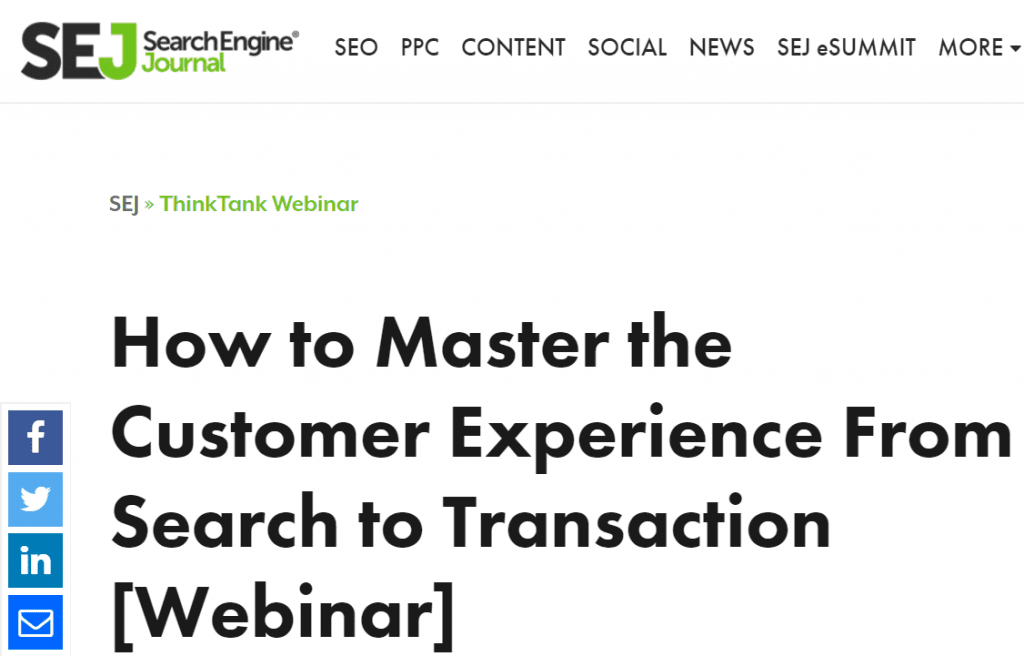
Video
Did you know that more video content is uploaded in 30 days than all the major US networks have created in 30 years?
Not to mention that YouTube has over 1 billion users and is the second-largest search engine in the world behind its owners, Google. So to say video content is important is a bit of an understatement!
Don’t fret if you’re completely new to video though, as simple, raw edits are authentic, and that's what matters to your audience.
With that being said, here are a few cases where you might wish to explore video content:
Events
Brand story
Product demonstration
Case study
A “how-to” or educational video
We use video to better tell our alumni’s stories, acting as a case study to demonstrate the success of our program.
Honorable Mentions
We’d love to cover each content format in great detail but to keep this guide concise (and under 100 pages!) we’ll summarize some other noteworthy formats you might want to explore with your business:
Checklists: A list of actions your reader should take (in order) to complete a given task. Ex. 5 Stages to Writing a Blog Post
Mini-course: Offering a snippet of a class or training session to give readers an insight into what the full course looks like.
Podcast: Audio content that users can later download and listen to at their convenience.
Newsletter: Sent to a registered user database, typically once a week informing them of product offers, updates, and other useful resources
Case Studies: Extremely important in showing readers the success your product has had, told through the experiences of customers.
Content Distribution
The final piece of the content marketing puzzle is distribution.
What good is all that great content you’ve produced if your audience isn’t reading it?
For it to succeed you need to get as many eyeballs on it as possible. To do so there are 3 different types of distribution channel:
OWNED MEDIA
EARNED MEDIA
PAID MEDIA
We’ll quickly break down each distribution channel and how it relates to your overall content strategy.
Owned Media
A company's owned distribution channels are those that they have full control over.
They decide where the content appears (blog, YouTube, website, etc.) and when it is shared.
Some of the most common owned distribution channels include:
Blog
Newsletters
Video channels (YouTube, Vimeo, etc,.)
Website (eBooks, white papers)
Apps
Social networks
Earned Media
This distribution channel revolves around having others share your content.
It’s considered the most credible distribution channel as it’s done so by external, unpaid sources. In other words, this content is so damned good I just had to go share it with my audience.
This is why content “virality” is so sought after as it means your brand reaches a wide audience without having to use paid distribution.
A solid SEO strategy also helps no end with your earned distribution, as your content will be in a better position on search result pages to be seen and engaged with.
Some examples of paid distribution are:
Social shares
Brand mentions
Content reposts
External product reviews
Non-sponsored guest posts.
Paid Media
While the first two channels are entirely organic, the final distribution is supported by the weight of your bank balance.
As long as the money continues to flow, it enables you to reach a continuously growing audience with advertisers happy to promote your content in exchange for hard cash.
Some of the options include:
Social media advertising
Sponsored content on media platforms
Paid guest posts
Native advertising tools such as Outbrain and Taboola
Paid influencer campaigns
Paid distribution can be a great tool if the budget is managed carefully and used to complement other distribution channels.
However, focusing solely on paid can be extremely expensive while the content holds less weight than its organic brethren.
Measuring and Testing Your Digital Content Strategy
Measuring your digital content marketing efforts is the final step in this guide.
It’s incredibly important to know whether what you’re doing is working. If not, how can you justify your work? That’s why the best digital content marketers tend to live inside Google Analytics.
“What can’t be measured, can’t be improved”
Now, measuring for measuring’s sake doesn’t help anybody. If you’re unsure about what KPIs (key performance indicators) to track, ask yourself these two questions:
Are these metrics related to my key business goals?
Am I able to act based on their results?
If the answer isn’t “yes,” then you probably don’t need to collect data on it.
Here’s a list of potential KPIs depending on your business goals and the content actions you implemented to achieve them:
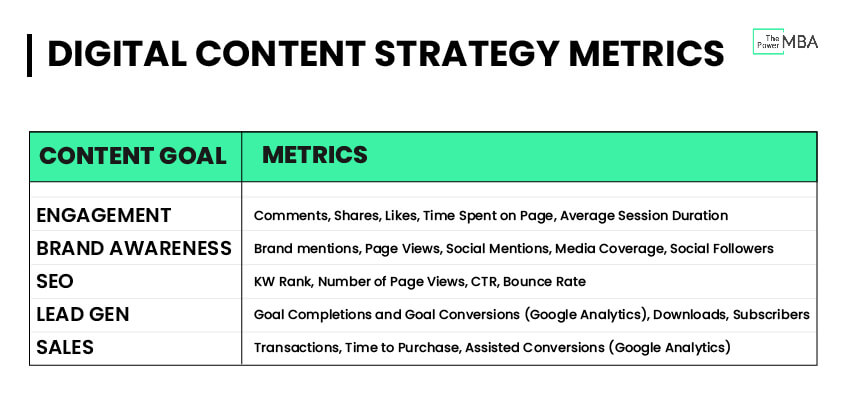
Also, when deciding on which KPIs you need to measure, think about frequency. How often do you want to collect data? Weekly, monthly?
Most organizations tend to do so once a month.
Conclusion
As you can see, content marketing is a great way to build brand awareness, trust, and a steady stream of leads to your business.
However, it’s a long-term strategy that requires time, effort, and a bit of trial and error to find which content resonates with your target audience, and which channels to distribute it through.
When you do uncover a winning formula for your business it’s simply a case of rinse, repeat, and scale up if possible!
If it’s a strategy you’d like to explore in a bit more depth then we recommend grabbing a copy of the following books:
Content Inc. by Joe Pulizzi
The Content Code, by Mark Schaefer
Everybody Writes, by Ann Handley






